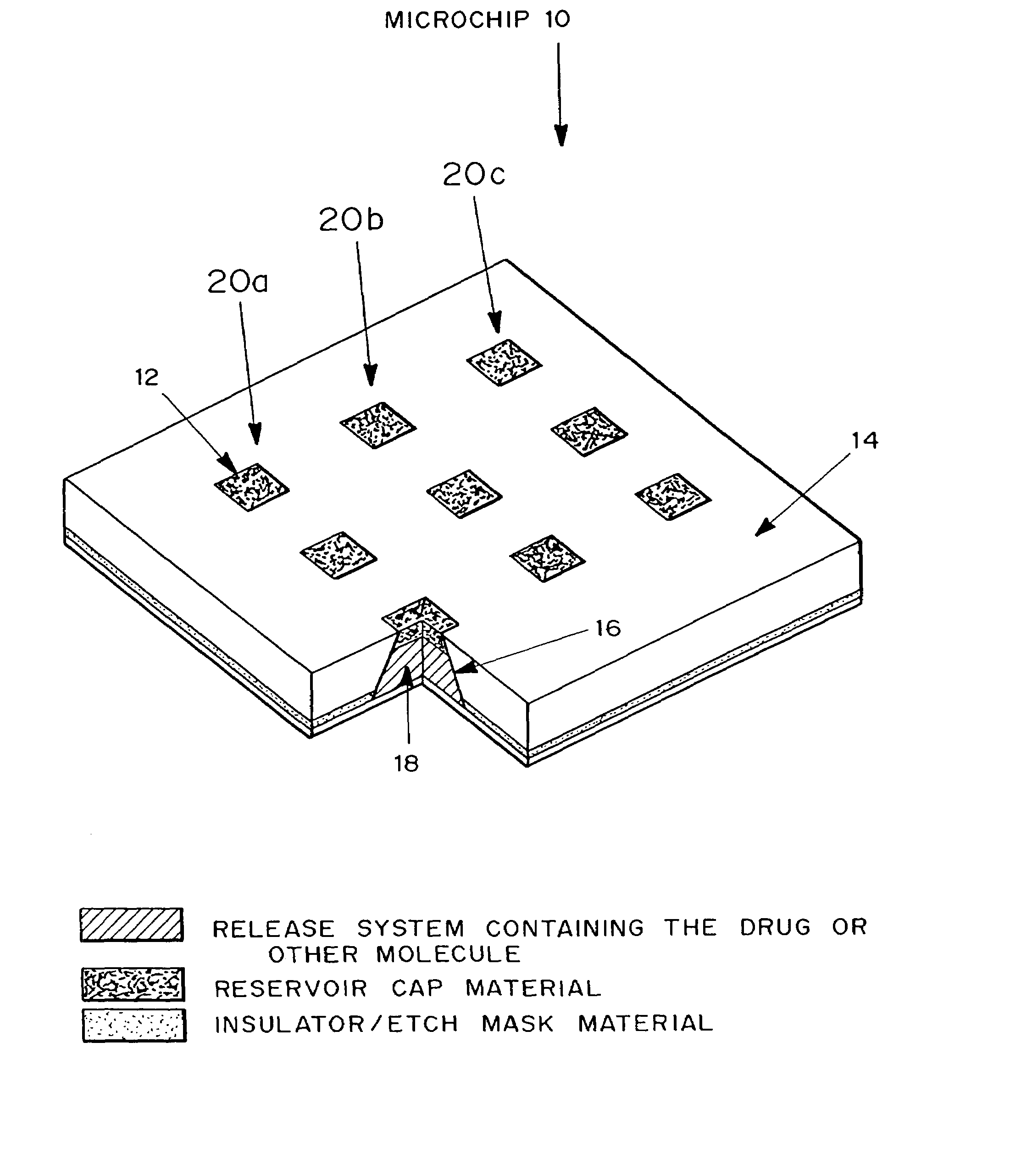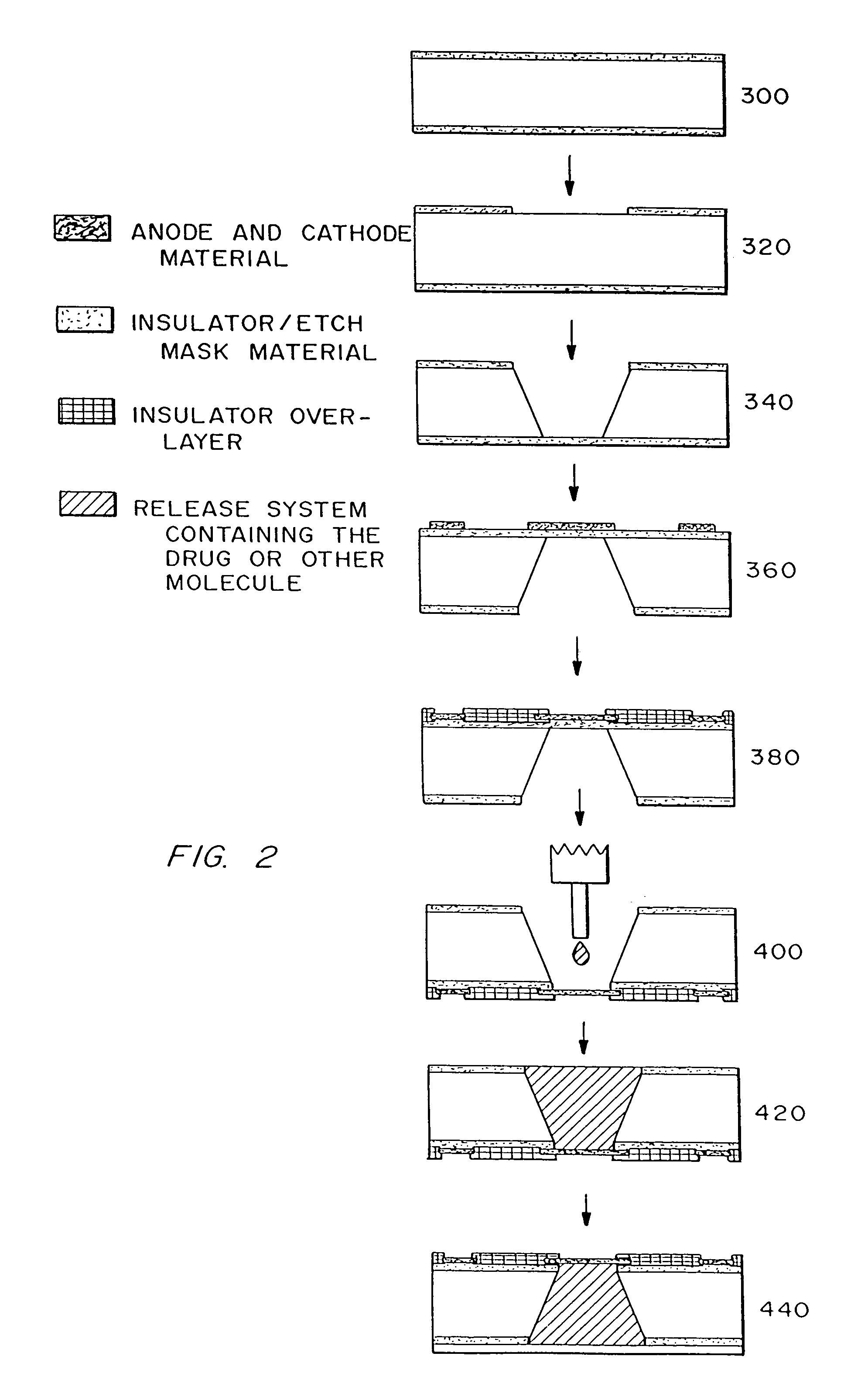Microchip drug delivery devices
a drug delivery and microchip technology, applied in the direction of transportation and packaging, other medical devices, electrolysis components, etc., can solve the problems of drug delivery, patients often forget, are unwilling or unable to take their medication, and drug delivery becomes problemati
- Summary
- Abstract
- Description
- Claims
- Application Information
AI Technical Summary
Benefits of technology
Problems solved by technology
Method used
Image
Examples
example 1
Fabrication of Active Release Microchip
1) Obtain double side polished, prime grade, (100) oriented silicon wafers.
[0075]Wafer thickness=approximately 295–310 μm
2) Deposit approximately 1600–1900 Å of low stress (10:1, silicon rich) silicon nitride on both sides of the wafers in an SVG / Thermco 7000 Series vertical tube reactor (VTR).
[0076]Gas Flows: Ammonia (NH3)=24 sccm[0077]Dichlorosilane (SiH2Cl2)=253 sccm
[0078]Temperature=780° C.
[0079]Chamber Pressure=268 mtorr
[0080]Deposition Rate=approximately 30 Å / min.
3) Pattern positive photoresist (PR) as squares (approximately 500 μm by 500 μm) serving as the large reservoir openings on one side of the wafers having low stress silicon nitride deposited on them.
[0081]Hexamethyldisilazane deposition on both sides of the wafer[0082](“HMDS vapor prime”) in vacuum oven[0083]approximately 30 min. at 150° C.
[0084]Photoresist (PR) Type—OCG825-20
[0085]PR Spin Speed and Times (for a Solitec Inc. Model 5110 spinner)[0086]7 sec. at 500 rpm (coat)[0087]...
example 2
Fabrication of Passive Release Microchip
[0181]1) Obtain double side polished, prime grade, (100) oriented silicon wafers for devices having reservoirs extending completely through the wafer or single side polished, prime grade, (100) oriented silicon wafers for devices having reservoirs that do not extend completely through the wafer.
[0182]Wafer thickness=approximately 295–310 μm for devices with reservoirs extending completely through the wafer (devices that do not have reservoirs extending all the way through the wafer can be of any desired thickness)
2) Deposit approximately 1600–1900 Å of low stress (10:1, silicon rich) silicon nitride on both sides of the wafers in an SVG / Thermco 7000 Series vertical tube reactor (VTR).
[0183]Gas Flows: Ammonia (NH3)=24 sccm[0184]Dichlorosilane (SiH2Cl2)=253 sccm
[0185]Temperature=780° C.
[0186]Chamber Pressure=268 mtorr
[0187]Deposition Rate=approximately 30 Å / min.
[0188]3) Pattern positive PR as squares (approximately 500 μm by 500 μm for devices w...
example 3
Microchip with Passive Timed Drug Release
[0240]A passive timed release device, microchip 10 is shown in FIG. 4. Microchip 10 is formed from substrate 14. Reservoirs 16 are etched into substrate 14. Positioned in reservoirs 16 is a release system containing molecules for delivery 18. The reservoirs are capped with reservoir caps 12. The release system and the molecules for delivery 18 can vary between rows 20a, 20b, 20c, and within reservoirs of each row.
[0241]Microchip 10 can be inserted into solution for in vitro applications or be implanted in a selected part of the body for in vivo applications and left to operate without requiring further attention. When exposed to the surrounding fluids, reservoir caps 12 will degrade or become permeable to the release system containing molecules for delivery 18.
PUM
| Property | Measurement | Unit |
|---|---|---|
| thickness | aaaaa | aaaaa |
| thickness | aaaaa | aaaaa |
| thick | aaaaa | aaaaa |
Abstract
Description
Claims
Application Information
 Login to View More
Login to View More - R&D
- Intellectual Property
- Life Sciences
- Materials
- Tech Scout
- Unparalleled Data Quality
- Higher Quality Content
- 60% Fewer Hallucinations
Browse by: Latest US Patents, China's latest patents, Technical Efficacy Thesaurus, Application Domain, Technology Topic, Popular Technical Reports.
© 2025 PatSnap. All rights reserved.Legal|Privacy policy|Modern Slavery Act Transparency Statement|Sitemap|About US| Contact US: help@patsnap.com



